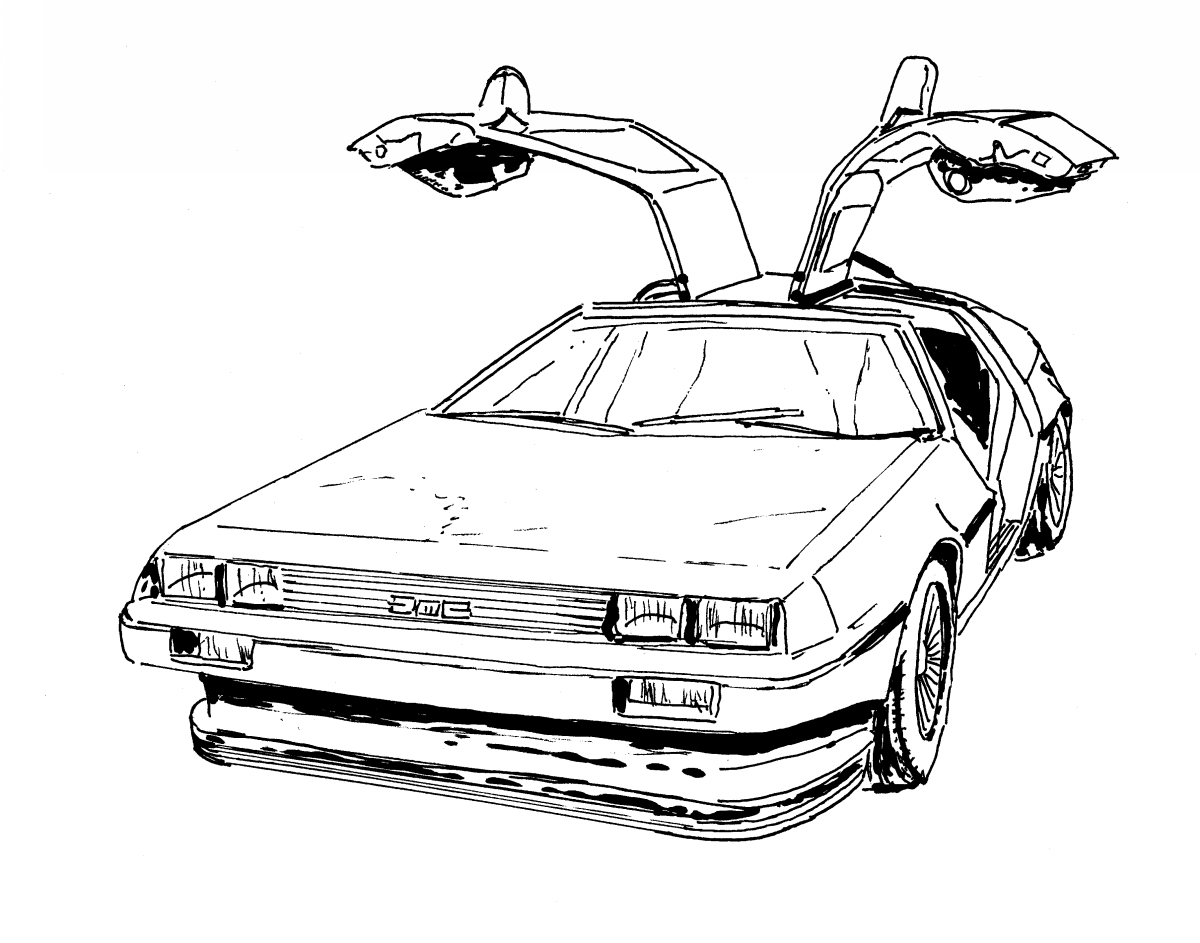Why can’t you catch a rocket to Mars?
“Wait a minute... Ah... Are you telling me that you built a time machine... out of a DeLorean?”
― Marty McFly
Have you ever wondered why you can’t catch a rocket to Mars? In a similar vein, you know that there is currently nobody living in ‘Moonbase-Alpha’ as Martin Landau was due to in 1999. On October 21, 2015, some of my students told me that it was the day Marty McFly was due to appear. Apparently, that is the date when McFly travels back in time to the 1980s in the film Back to the Future: Part II
. I have not seen it but was told that in the movie we learn that in 2015 there are technologically advanced devices and that people travel around on hover-boards (looking rather like surf boards but able to hover in the mid-air). I said to the students: “well, Marty must be bloody disappointed since we are still travelling around on old technology diesel buses” and they laughed. Not only do we not have hover-boards, we don’t even have a lightweight, clean low-cost power source to power a car (as I write this electric cars are finally becoming available, but they remain expensive and with limited range). By the way, as you no doubt know, as mentioned in the quote above, Back to the Future
features a time machine in the form of a DeLorean. Now, to anyone who says the DeLorean is a useless car, all I can say is that I won’t have that; and they will eat their words the next time they find themselves having to work out some aesthetic styling for a new time machine!

The DeLorean; perhaps not much of a car, but a great looking time machine! (Pen and ink drawing by the author.)
A couple of years ago, I was in conversation with a company scientist who remarked that he was impressed, even bemused, by the technological advances we are seeing. I couldn’t help saying that I was bemused by the apparent lack of significant technological progress and gave the example of the car which has hardly advanced in its fundamental design and operating principles in the last one hundred years – only having become somewhat more reliable and efficient. He was forced to concur. As the American technologist, Peter Thiel, expressed it: ‘We wanted flying cars, we got 140 characters.’ Also, I must point out that there was not an expedition to the planet Jupiter in 2001 and there has been little progress towards being able to fly around the Galaxy in a spacecraft visiting various exo-planets, as Kirk and Picard do in the seminal TV series Star Trek
.
James T. Kirk (above) and Jean-Luc Picard (below); starship captains from
Star Trek
. (Drawings by the author.)

In short, technological progress in the last one hundred (and particularly the last fifty) years, has been, it has to be said, less than we had expected or might have hoped for. And this means that the challenge of getting to Mars is currently a relatively formidable one. It’s not that a Martian round trip is impossible with current day technology – it’s just that, up to now, the challenge of doing it has not really been focused on or taken seriously. But recently, and excitingly, that has all changed. In 2033 the relative position of the
Earth and Mars will be favourable for making the journey and so NASA plans to go there during that year. Meanwhile, Elon Musk’s space travel company SpaceX, which so far has been very successful in its endeavours, is even more ambitious, and is planning a mission for 2024. But what would be involved in getting humans to Mars (and returning them) in an affordable and safe way?
First of all, we need a rocket. SpaceX is developing a ‘Starship’ spacecraft and Super Heavy rocket (collectively referred to as ‘Starship’). This will be a reusable transportation system with the following planned characteristics: height 120 m, diameter 9 m and ability to carry in excess of 100 metric tonnes to Earth orbit. Impressive, eh? Once the Starship is in orbit the plan is to refill it with fuel from a tanker which then returns to Earth. The refuelled Starship will then break out of orbit, travel around the Sun and on to Mars – which will take about 6 months (it takes a while since although Mars will be relatively close to Earth in 2033, it will still be at a distance of about 35 million miles). After arriving at Mars, Starship will achieve a soft landing and then use local reserves of H2
O and CO2
to re-fuel. After being fully re-fuelled it will make its Mars assent and then return directly to Earth. Does this sound too straightforward to be plausible? Sometimes the simplest plans are the best. But we can’t assume it will be cheap – the cost of a mission to Mars might come in at the better part of a trillion dollars.
What will it be like when we get there? Mars is about one and a half times as far from the Sun as the Earth, so the sun will still be bright and will rise in the morning (days are about the same length as for the Earth). But since it is father from the Sun than the Earth and with a thinner atmosphere, it will be a bit chilly. Its atmosphere is primarily CO2
with some nitrogen and argon and a few other trace elements, which will allow us to grow plants on Mars (a bit like in the film The Martian
). Gravity on Mars is less than half of that of Earth, so I would be able to lift heavy things and my backache would be cured without the need for me to go on a diet. (The latter being the most important consideration as far as I am concerned.) Speaking of food, we would need to take a good deal of it with us and this may also be one of the rare occasions when being somewhat overweight
would provide an advantage – more natural personal reserves would mean a better chance of survival if supplies ran low and/or that less food would be required for the voyage. It’s sounding better suited to me all the time – I am more or less ready to go!
If you think all of this sounds a bit far-fetched, then think again. SpaceX has already launched the ‘Falcon Heavy’ rocket three times. This is by far the most powerful operational rocket in the world and is able to lift nearly 64 metric tons of payload into orbit. And their plan for the near future is to have the test flight of the Falcon Heavy that will demonstrate SpaceX’s ability to send spacecraft beyond Earth’s orbit. You might be asking if there will be any associated hazards for astronauts on a voyage to Mars and the answer is of course yes. Apart from the boredom or even mental health issues associated with being confined in a relatively small rocket for such a long period, there will also be dangers associated with cosmic and solar radiation that can damage the vision, and even cause dementia and/or cancer. Just getting to Mars would expose one to more than 15 times the recommended annual radiation exposure limit – although some limited protection may be provided by extra metallic shielding.
So, what can we conclude from these considerations? To summarise, even with today’s technology, it is possible for mankind to make a journey to Mars, albeit a relatively hazardous and time-consuming one, and it is quite likely that such an expedition will occur around the year 2033. But it would be much less hazardous and time-consuming if we could significantly increase the speed of our rockets. And in fact, increasing the speed of rockets well beyond the current record of 20,000 mph would not be as difficult to achieve as you might imagine. We just need to burn the rocket motors for a considerably longer period – which naturally necessitates more fuel. This could be facilitated by getting a rocket into orbit that has an extremely large (empty) fuel tank attached, and then filling the tank with multiple visits from space tankers.
So, we can get to Mars and back, even with the limitations of current technologies. But although our title refers to catching a rocket to Mars, which is something we can do with currently available
equipment, this book is not intended to specifically address current technology. Rather, its main focus is on what future technological achievements might be possible if we could unshackle and focus our research and development efforts, and the exciting outcomes that could ensue. These would certainly include quicker, easier and safer travel to Mars than is currently possible. However, perhaps the most astounding possibility would be the prospect of exploration well beyond the Red Planet to the nearest star, and perhaps even beyond...
But let’s preface our considerations of the future by first reflecting on some of the achievements of previous centuries, to see if we can draw inspiration from the scientists and engineers of the past. We will discuss science in some detail a little later, but first I would like to consider engineering.



